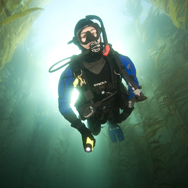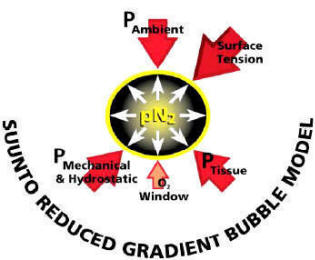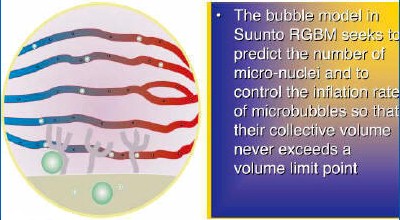How to Use and Choose Dive Computers
During a scuba dive, nitrogen from your breathing air dissolves into body tissues due to the increased pressure. The
deeper you dive, the faster nitrogen dissolves into your body. It’s important to keep this dissolved nitrogen within accepted limits to minimize the risk of decompression sickness. To do this, your dive computer tracks your dive depth and time. It calculates theoretical nitrogen using a decompression model and displays the time and depth limits you need to stay within.
Also known as : deco meter, decompression meter, decompression computer, scuba diving computer, dive computers with full decompression models.
Styles

There are two basic styles of dive computer.
Independent – These computers are separate gauges that you wear on your wrist or as part of an instrument console.
Integrated – These computers integrate with your SPG and/or other instruments, such as an electronic compass. By also measuring your air supply, some models can estimate how much time your remaining air gives you based on your depth and how fast you’re breathing.
Required features
Easy to read display – You consult your computer constantly while diving, so choose one that makes sense to you and that you can read easily.

Low battery warning – Once activated, a dive computer will need to run 24 hours or longer to calculate changes in dissolved nitrogen. The computer must be able to warn you if it won’t have enough power to do that. Virtually all modern computers have this feature, alerting you to change the battery before starting your dives.
Enriched air compatible – This allows you to set the computer to dive enriched air nitrox. Enriched air gives you longer dive times, all else being equal, and the setting tells the computer to track your exposure to oxygen. At one time considered an option, today diving with enriched air nitrox is so common that you’ll want to become qualified to use it shortly after becoming a PADI Open Water Diver. Virtually all modern computers have this ability.
Optional features
There are many options in dive computers. Some of these are very important for specific types of diving, whereas others are personal preference.
- Hoseless integration – Some integrated computers receive air supply information from a transmitter on the regulator first stage. This eliminates a hose and allows you to wear an integrated model on your wrist.
- Watch sized – Some of the newest dive computers (integrated and non integrated models) double as digital dive watches
- Multiple gas – Aimed primarily at tec diving, you set these models for two or more different types of enriched air or even trimix (a tec diving blend of helium, oxygen and nitrogen). This allows the computer to calculate as you switch gases during the dive.
- Audible warnings – Most computers sound an alarm if you ascend too fast or near a limit.
- Computer download – Some computers interface with your PC so you can download your dive data. This provides detailed dive information and is a convenient way to keep a computerized dive log. You can also purchase a PADI paper log book from your local dive shop.
How to choose a dive computer
Choosing a dive computer is a matter of personal preferences and cost-versus-features.
Get your PADI Instructor or a dive professional at Easy Divers dive shop to help you. The options and choices can seem overwhelming, but your PADI pro can narrow it down very quickly by asking you a few simple questions.
Tips
- Don’t share it and don’t turn it off. A dive computer tracks changing theoretical gas levels for each individual diver during a dive, between dives and during a second dive. Therefore, you can’t share it during the day. If you turn it off, it loses its memory of your previous dives (not good!), which means you can’t dive any more for at least 24 hours. You can’t turn off most modern computers, but changing the batteries during the middle of the day can be a problem. See the manufacturer instructions.
- User settable alarms are awesome. It’s great to have a computer with automatic warnings, and new divers shouldn’t turn the alarms off indiscriminately. On the other hand, some warnings are annoying and unnecessary for experienced divers, so it’s nice to have the option to turn them off.
How does a dive computer work?
The dive computer performs a continuous calculation of gases in the body based on the actual dive profile. As the dive computer automatically measures depth and time, it reduces the need for the diver to carry a separate watch and depth gauge and is able to warn of excessive ascent rates and missed decompression stops.
Algorithms
A main differentiation between different brands of dive computers (beyond look and feel, price and obvious features (backlight, audible alarms etc)) is which algorith they use: there’s the Haldanian algorithm, Suunto’s Reduced Gradient Bubble Algorithm and a number of others with various merits, used by different manufacturers.
Debate is never ending about which algorithms provides the best results, quite frankly, nitrogen gas bubble formation in human tissue (â€the bendsâ€) seems to be a field in biology that isn’t particularly well-understood.
A key thing is that different algorithms and different dive computers ‘ implementation of those algorithms can be more or less conservative or aggressive: An “aggressive†computer gives more bottom time than a “conservative†one does, and it’s wise to understand the properties of one’s own dive computer to ensure it fits the skill and comfort level expected.
SUUNTO RGBM
SUUNTO REDUCED GRADIENT BUBBLE MODEL | Most Advanced Dive Computers In The World Today

| The Suunto RGBM is a modern algorithm for predicting both dissolved and free gas in the tissues and blood of divers. The Suunto RGBM is a significant advance on the classical Haldane models, which do not predict free gas (micro bubbles). It was developed in a co-operation between Suunto And Bruce R. Wienke BSc, MSc, PhD. The Suunto RGBM is based on both laboratory experiments and diving data, including data from DAN.Suunto RGBM adapts on-line to a variety of situations, such as:- Monitoring continuous multiday diving- Computing closely spaced repetitive diving
– Reacting to a dive deeper than the previous dive – Adapting for rapid ascents which produce high micro-bubble (silent bubble) build-upBy adapting the decompression obligations according to the actual dive situations, Suunto RGBM improves the safety of your diving. |
![]()
SUUNTO REDUCED GRADIENT BUBBLE MODEL (RGBM)
Suunto Advanced RGBM Micro Bubble Dive Model
– EXCLUSIVE TECHNOLOGY –

Suunto of Finland, incorporates the latest research in decompression theory in a dive computer, which led to the development of the most advanced dive computers in the world today.
Updating to a new Suunto dive computer can make your diving safer, extend your bottom time, save you money (due to improved battery technology) and more convenient (due to reduced size). You can even make a fashion statement with one of Suunto’s advanced wristop computers.
SAFETY FIRST
There are many reasons to trade up to a Suunto computer, safety being the #1. The most important difference from one dive computer to the next, is its decompression algorithm. It is also the most difficult feature to explain and most costly to develop.  As a result more obvious but less important benefits are often used as the key selling feature, which leads many manufacturers to place less emphasis on this critical safety factor.
Most divers are lucky enough to never have a problem with decompression illness, however each year thousands of divers throughout the world do. More importantly research over the last decade has shown that long term damage to soft tissue (the brain, spinal tissues and the retina) are far less likely if you use a dive computer incorporating the latest research on prevention of micro bubble build up.  Divers who dive very regularly, like instructors and professional divers are most susceptible to the long term affects of micro bubbles, but any diver that does multi day diving, for example on a vacation, will be affected by micro bubble build up. Therefore, understanding what the SuuntoReduced Gradient Bubble Model (RGBM) can do to make your diving safer is critical to most divers.
The Suunto RGBM is a modern algorithm for predicting both dissolved and free gas in the tissues of divers performing a wide variety of maneuvers. It was developed in co-operation with SUUNTO and Bruce R Wienke (BS, MS and PhD) and is based both on laboratory experiments using highly advanced Doppler Bubble detection devises and is supported by Divers Alert Network’s (DAN) dive data, folding both in coupled synthesis for safety.
Suunto Stinger |
| State-of-the-art solutions for every diverSuunto Stinger is a full decompression dive computer and a beautifully constructed compact-size watch in steel or titanium. |
| Suunto Stinger Story |
| Suunto Stinger has everything a diver can ask for. It is a wristop computer with separate Air, Nitrox and Free/Gauge modes, each of which has a detailed profile memory.All the advanced features, such as safety stop countdown, adjustable profile memory sampling rate, underwater stopwatch and bookmarks, are easily accessible.In addition to having information available to you at all times, Suunto Stinger records and stores data for later analysis. You can view, compare, and analyze your diving performance through a specially designed PC interface.The technical features, combined with the PC interface developed for more graphical representation of your performance, and our Internet Community, where you can share information with other like-minded divers from around the world, make Suunto Stinger thedevice of choice for every diver and underwater explorer. |
| Deeper Understanding |
| Suunto Stinger is a highly sophisticated multi-level dive computer, in every sense of the word. It monitors and reports vital information such as your dive time, current depth, maximum depth, no-decompression time and ascent time.Suunto Stinger implements a Suunto-specific ceiling and floor feature. The decompression floor is the deepest point at which the ascent time will not increase. The decompression ceiling is the shallowest depth to which you should ascend. These depths provide the range where the diver utilizes the decompression stop morefore your dive. The clear electro-luminescent backlight is activated automatically when dive alarms are given, making the dive parameters clearly visible and legible. The system is highly energy-efficient with only minimal power consumption. The built-in dive planning function helps you plan your next dive by showing you the no-decompression time data for different depths.In the Nitrox mode, you can program Suunto Stinger for nitrox mixtures of 21% to 50% oxygen in 1% increments. You can also adjust it for oxygen partial pressure from 1.2 bar to 1.6 bar in 0.1-unit increments.Suunto Stinger gives both visual and audible alarms when the limit for oxygen partial pressure, CNS or OTU values are exceeded.For freediving enthusiasts, Suunto Stinger introduces a 1-second precision timer with selectable 2, 4, 10, 20, 30 or 60-second profile memory-sampling rates. After 5 minutes of continuous diving in the Free mode, it automatically switches to Gauge mode. In both the Free and Gauge mode you can use a run-time timer. This makes Suunto Stinger also ideal for technical and military diving.In the Air and Nitrox modes, you get a 36-diving hour profile memory with a default 20-second sampling rate setting. You can adjust the sampling rate to 10, 30 or 60 seconds through the PC interface. You can view the profile memory and long-term history data on the Suunto Stinger display.Suunto Stinger incorporates complete calendar clock functions,dual time, daily alarm and a stopwatch with elapsed time and split time measurement. If you disable all the dive modes, you can use it as a traditional dive watch.The casing is all stainless steel and the display is scratch-resistant mineral glass. The triple o-ring pushbuttons and its monocase design without a separate rear cover make Suunto Stinger virtually leakproof. The pressure rating is 20 ATM (200 m/660 ft).Suunto Stinger comes with a durable, gray elastomer strap, or optionally a solid stainless steel bracelet with polished center-links. The bezel color is silver. The top-of-the-line model is Suunto Stinger Titanium, with a solid titanium housing and bracelet. |
![]()
![]()
![]()
|
|



